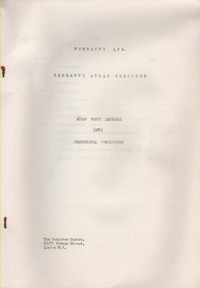Ferranti Atlas Basic Language (ABL)
| Home > Browse Our Collection > Manuals > Ferranti > Ferranti Atlas Basic Language (ABL) |
|
12-page manual. Atlas Basic Language (ABL) is a symbolic input language close to "machine language". Each ABL instruction corresponds to one machine instruction, and each part of an ABL instruction to each part of a machine instruction. In its simplest form an ABL instruction consists of four numbers corresponding exactly to the internal machine representation, but extensive facilities are also provided in ABL for the use of a variety of parameters and symbolic expressions which are evaluated by the ABL compiler. ABL also provides a comprehensive system of directives to control the assembly of a complete program. Finally ABL provides facilities for the input, conversion and storage of fixed-point numbers, floating-point numbers and character strings for use by the program. The Atlas Computer was a joint development between the University of Manchester, Ferranti, and Plessey. The first Atlas, installed at Manchester University and officially commissioned in 1962, was one of the world's first supercomputers, considered to be the most powerful computer in the world at that time. It was said that whenever Atlas went offline half of the United Kingdom's computer capacity was lost. It was a second-generation machine, using discrete germanium transistors. -Two other Atlas machines were built: one for British Petroleum and the University of London, and one for the Atlas Computer Laboratory at Chilton near Oxford. A derivative system was built by Ferranti for Cambridge University. Called the Titan, or Atlas 2, it had a different memory organisation and ran a time-sharing operating system developed by Cambridge Computer Laboratory. Two further Atlas 2s were delivered: one to the CAD lab at Cambridge, and the other to the Atomic Weapons Establishment, Aldermaston. The University of Manchester's Atlas was decommissioned in 1971, but the last was in service until 1974. Parts of the Chilton Atlas are preserved by the National Museums of Scotland in Edinburgh. We are extremely grateful to both Dawn and Kim Wakefield for the kind donation of the collection of their late father Richard Wakefield.
This exhibit has a reference ID of CH15676. Please quote this reference ID in any communication with the Centre for Computing History. |
Click on the Images For Detail
|










